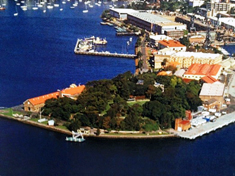December 2019
By Colin Randall
Colin is a volunteer researcher with the Naval Historical Society of Australia and a tour guide for its heritage tours of the Hill. He lived in Residence ‘C’ on Garden Island while attending high school and university, and has an intimate knowledge of the Naval Garden, as it was essentially his playground and backyard from 1961 until 1970. His father was ex Royal Navy, ex Royal Australian Navy and worked for the Department of the Navy in planning ship refits. Colin’s grandfather was on the Australia Station on HMS Pegasus and HMS Powerful based at Garden Island from 1908 until 1910.
This story was first published by the Australian Garden History Society in the Australian Garden History Journal, October 2019.
The historic naval base at Garden Island Naval Precinct in Sydney Harbour was listed on the Commonwealth Heritage List and NSW State Heritage Register in 2004. The naval garden on Garden Island has been shaped by the development of Australia’s major naval base, the activities of the Royal Navy on the Australia Station, the opening of the First Parliament of the Commonwealth of Australia and the creation and activities of the Royal Australian Navy.
Garden Island and nearby Potts Point are high points above sea level of the drowned river valley that now forms Sydney Harbour, which was itself formed between 10,000 and 6500 years ago as sea levels rose following the last glaciation. In 1788 the sandstone island was vegetated with low coastal heath and woodland. The island had hummocks at its north (24 metres high) and south (20 m) ends, with a lower flat area between them.
An Early Garden
Garden Island was the site of one of the first gardens planted by the First Fleet in 1788 and provided onions and corn for the crew of HMS Sirius. The area chosen for the garden was the flat land between the island’s northern and southern hills.
For nearly 20 years it was the site for ships’ gardens, supplying a series of Royal Navy ships. The lack of a permanent water supply was always a limiting factor in the success of the gardens. The northern end of the island had a battery established in 1796 to protect Sydney from potential attack by French warships. Governor Macquarie in 1806 brought Garden Island into his Domain and the island was used as a place for raising of chickens for the Governor’s table.

Alexander Harris, a visitor to Sydney in the 1840s, described Pinchgut Island and neighbouring Garden Island to the southeast as ‘two small scrub clad piles of hoary stones, each standing solitary amidst the whistling winds of the Stream’.
Uncertain Water
Throughout the early and mid-1800s Garden Island became a popular picnic site for Sydney siders. The lack of water and facilities, however, limited its appeal, with everything having to be brought with the picnickers.
With the decision in the 1865 to create a naval base for Royal
Navy ships on the Australian Station (the Australian region’s seat of command for the British Navy), the island was taken back from the control of NSW and ship’s boat repair facilities were constructed.
The lack of a permanent water supply to the Island remained an issue, with water supply coming from rainwater capture and delivery by barge. However there was sufficient water for a lawn tennis court to be laid down in 1880 in part of the area originally used by the ship’s garden. The sport of tennis was first introduced to Australia around 1875 and Royal Navy and Marine officers were keen exponents.
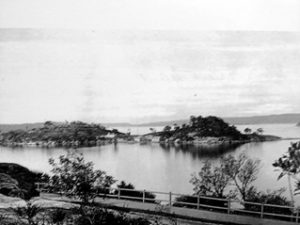
Occupation
The major transformation of Garden Island followed the levelling of the southern hill and included the erection of barracks for Royal Marines and sailors. Cottages built in 1885 for the supervisors of the construction were then turned over for use by naval staff. With the construction of the new barracks on the site of the original tennis court, a new tennis court was constructed on the northern hill
The tennis courts were built adjacent to rock carving with the initials of a survey party and the date 1788. Until the building of this new tennis court in 1885 the Hill was representative of the native vegetation on what were the sandstone outcrops.
The water supply problem for the island was solved in 1889 when NSW Harbours and Rivers Department laid a water main under the harbour from Potts Point to the southern end of the island. Water was then reticulated around the island through a 15 inch main.
Additional works on the Hill for pathways and levelling in the late 1880s discovered the two cannons that had been installed in 1796 and abandoned. A 6 pounder and 4 pounder, reportedly from HMS Sirius, were refurbished and placed on their appropriate gun carriages and reinstalled looking towards Fort Denison.
Garden Island (lower) and Pinchgut Island in Sydney Harbour, ca 1818, by Edward Charles Close (formerly attributed to Sophia Campbell). National Library of Australia.
By 1896 the Hill not only had paths leading to the tennis court from the residences but a ‘rustic summer house’ adjacent to the flagstaff on the peak of the Hill. Paths also led to the harbour swimming pool at the north end of the island.
Royal Visit Plantings
On 9 May 1901 the Duke of Cornwall opened the first Parliament of the Commonwealth of Australia in Melbourne. Later that month he travelled with the Duchess of Cornwall to Sydney. On 30 May 1901 in Sydney Harbour he undertook a formal inspection of ships of the Australia Station as well as the naval depot on Garden Island. The Duke and Governor-General Lord Hopetoun (Australia’s inaugural Governor-General) travelled from Admiralty House at Kirribilli by steam launch, and inspected a guard of honour in front of the Garden Island barracks.
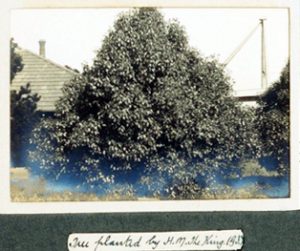
To mark the occasion of their visit the Duke of
Cornwall and the Governor-General (on behalf of
the Duchess of Cornwall) ceremonially planted
trees at a site on the western side of Garden
Island’s Hill. Joseph Maiden (who was Director of the Botanic Gardens 1896–1924) had selected two trees for their longevity, and supervised the planting. The Duke of Cornwall planted a Port Jackson fig (Ficus rubiginosa) and Lord Hopetoun a hoop pine (Araucaria cunninghamii). These are amongst the 15 trees on Garden Island identified on the City of Sydney Register of Significant Trees.
The royal visit of the Duke of Cornwall to Garden Island would have initiated a tidying up and defining of the paths leading to the site of the tree planting adjacent to the tennis court. White painted rocks were no doubt the order of the day. Photographs taken in about 1910 shows a path on the eastern side of the Hill leading from the residences towards the swimming pool.
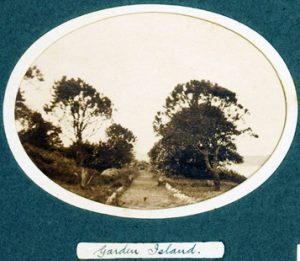
Interesting Objects
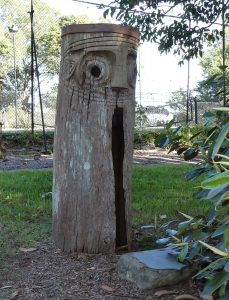
The inclusion of ‘interesting objects’ in the naval garden appears to become part of the tradition. One example is the slit drum from the Solomon Island collected on Mallo Kollo [Malakula] by Commander AHCC Home RN HMS Pegasus 1910 and installed in the garden. The drum was collected during punitive raids by Royal Navy bluejackets following attacks on missionaries.
With the changeover from the Royal Navy to the Royal Australian Navy in 1913, Garden Island came under new management. The six residences housed naval officers and civilians essential for the running of the naval base including general manager, master attendant and chief stores officer.
In September 1914 the Royal Australian Navy took control of Rabaul from the Germans. A trophy of that attack was a chain fence, which was brought back to Garden Island and erected in the garden. The construction of an oil tank in 1917 necessitated a bridge to provide continued access to the garden on the western side.
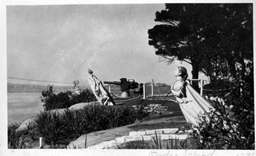
In the 1920s the island’s general manager erected a naval gun from the German cruiser SMS Emden and two ship’s figureheads as embellishments to the gardens. White painted rocks and boiler bricks were in evidence.
On 15 April 1936 Governor-General Lord Gowrie inspected the Garden Island naval depot and HMAS Moresby andPenguin (ex Platypus), the depot ship. To mark the occasion (commemorated by a brass plaque) he planted an outeniqua yellowwood (Afrocarpus falcatus), a southern African conifer, on the Hill.
In 1941 underground tunnels were excavated with a fan shaft sited adjacent to the tennis court pavilion. The excavation was for the emergency diesel electricity generator. By 1943 the Emden’s gun had gone but the figureheads remained. The use of pipe and wire fencing were utilitarian features of the garden.
Fuel tank construction in August 1917, just south of the trees planted by Duke of Cornwall and Lord Hopetoun. Defence image

Over the next 40 years there were more additions and variations to the stonewalls and garden beds. In particular, in 1985 an expansive stone platform looking out to Fort Denison and the harbour was constructed. This provided a convenient place for photographs with visiting dignitries as well as the annual apprentices photograph. Wooden objects felt the passage of time with the gun carriages needing to be replaced while the slit drum was reduced in height through repairs.
The most striking change in the last 20 years is the growth ofmany self-seeded trees including outeniqua yellowwood (Afrocarpus falcatus)and the reduction in the direct views of the harbour from The Hill. However, the newly installed walkway to the top of the old signal station now provides the best 360 degree view of Sydney and the harbour.
The recent addition of a new individual memorial garden underlines the strong continuing connection many in the Royal Australian Navy still have with the garden on The Hill.
Heritage tours of the Hill at Garden Island
Volunteer guides from the Naval Historical Society of Australia conduct a heritage walking tour of the Hill on one Sunday each month. Some guides are ex-Navy, others – such as Colin – have worked or lived on the island for many years. As well as learning about the island’s fascinating history, there is one of the best 360 degree views of Sydney Harbour from the top of the signal station.
Access to Garden Island is by ferry from Circular Quay, leaving at 9.50 am. The Sunday tour starts at 10.15 am at the Garden Island ferry wharf.
For further information or to book a tour, see https://navyhistory.au/productcategory/tours/. Tours are limited to 30 people.
